

|
|
Empty Nest Magazine
|
Gift of the Maasai: A Problem-Free Philosophy by Phyllis Eckelmeyer
Changes, They Are a Comin’ With my kids grown and out of the house, our septic tank was happy, and I knew there was food in the refrigerator. I missed the excitement of our teenagers and the mom-to-son and mom-to-daughter talks, but after college graduation, the kids settled about half an hour from the nest, so all was good. Even though I felt extremely fortunate to still be part of their lives, and would ultimately be involved with their spouses and our six grandchildren, my life was changing dramatically.
Backstory 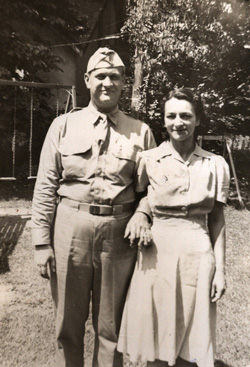
Phyllis’s parents, George and Miriam Gaumer, c. 1940.
My father, who served in Iceland as a medical doctor in World War II, died suddenly of a stroke when I was 10. So, my mother raised her three daughters on a limited income, determined that we all would graduate from college. My relationship with my mother and sisters was a source of great strength to me. Although I had difficulty learning to read in first grade and didn’t have a lot of confidence, I had a very traditional childhood. I loved to dress up and play “cowboys and Indians,” and I always wanted to play the Indian (Native American) princess. As a child, I enjoyed athletic activities such as softball, bike riding, table tennis, and ice skating. I also liked Girl Scouting, summer camp, and swimming with the local swim club’s team. Taking after my mother, who was a nurse, I was always interested in helping people, and as a young teen, I liked to babysit for neighborhood children. I loved to dance with my sister while watching Dick Clark and American Bandstand. After my father died, I learned to value life and to enjoy and make the most of each day.
Family and Career
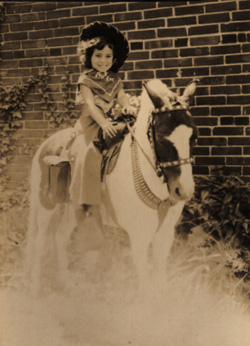
Phyllis (5) enjoying a session at the riding academy, in Oreland, PA.
When our daughter was 10 years old and our boys were in high school and college, I started a nonprofit adult day care center in a local church. We provided daily care for elderly patients, including my mother, who was suffering from dementia. Five years later, after my mother passed away and our second son was headed to Penn State, I decided to change directions again. I took a civil service exam and was hired as a social worker with Bucks County Children and Youth Services. That position opened my eyes to many serious social problems in our community as I worked with at-risk families who needed help. I empathize with children and parents who struggle financially and who suffer from poverty, addiction, and lack of an education.
New Adventures
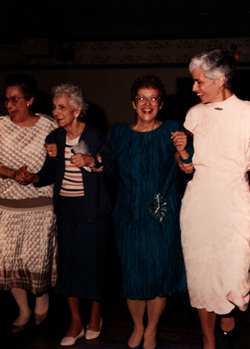
Phyllis (far right) and sisters Arlene (left) and Mary (right), with their mother (Miriam), in June 1992.
Looking through the paper for a part-time job one day, I saw an ad for modeling classes and thought I’d give it a whirl. An old friend thought I looked like Sara Lee (the cupcake lady) and encouraged me to get into commercials. After working up the nerve to walk on a catwalk in high heels with teen girls younger than my daughter, I took the classes and entered a beauty pageant. To my horror, it included a bathing suit competition. Spider veins, gray hair and all, I pulled it off and won first prize—acting classes! I learned the ropes in the modeling world and soon was asked to teach runway and modeling at several schools. Print work offered nice dividends, and I booked jobs with L’Oréal, Lactaid, Hershey Hotel, Sub-Zero Refrigerator and Wolf Stoves, Verizon, Vanguard, Rite Aid, and so on.
I also started landing commercials and did some extra work in a few films, such as Unbreakable and Twelve Monkeys with agents in Philadelphia and NYC. I began modeling regularly on QVC and acting in community and regional theater with roles like Ethel in On Golden Pond.
Meeting the Maasai I figured I better start looking at the atlas and travel magazines to see where she was going. I found out that Nairobi is the capital of Kenya and that a tribe called the Maasai lives there. The Maasai are frequently pictured in travel magazines promoting tourism in Kenya and Tanzania. I realized that Kenya is far away and that a lot of people get horrible diseases in Africa. I also knew I had better get myself an email account if I wanted to communicate with my daughter while she was away. In May 2004, about a week before Allyson was scheduled to leave for Nairobi, I was on my way to NYC for an audition. While I waited at a New Jersey train station, five distinctive African men stood next to me on the platform; they were wearing red plaid robes and intricately beaded tunics and jewelry. With my daughter leaving soon to teach at the Rift Valley Academy (RVA) in Kenya for an entire year, I seized the opportunity to ask the gentlemen about their heritage and share my daughter’s plans. Introducing themselves in English as Maasai from the Great Rift Valley, they knew RVA. Reassuring me with “Hakuna matada” (no worries) and saying, “Don’t worry about your daughter,” they promised to visit her in Kijabe and help her feel welcome. They shared that they were traveling to New York City to speak at the United Nations Forum on Indigenous Issues, advocating women’s rights, education, water, and health.
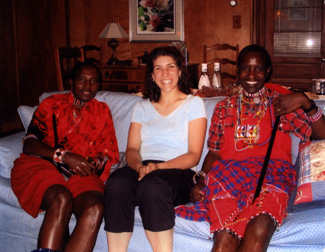
Daughter Allyson with Godfrey (left) and Francis (right), during the Maasai's first visit.
Mr. Sakuda, founder of the NGO (nongovernmental organization) SIMOO (Simba Maasai Outreach Organization) spoke about his dedication to improving the living standards of the Maasai community. He described the intense problems of daily life without clean water and how that was such a threat. We told Francis and the others that we were planning to visit our daughter in December, and the Maasai insisted that we come to their village, too. My husband had just had both knees replaced and wasn’t sure he could use the pit latrines in their compound, but Francis assured him that it would be fine. We talked a lot that night, and it was becoming clear that my road was taking another direction—one that was leading to Kenya. I suggested that we establish a U.S. nonprofit organization to receive public donations for water, education, and the empowerment of women. We discussed various fundraising ideas, such as scheduling Maasai presentations at schools and community events and a “Walk for Water” around Lake Galena, in Bucks County. I asked Francis if he would come back to the United States and give cultural programs in our area, and he said he would.
A Second Maasai Visit
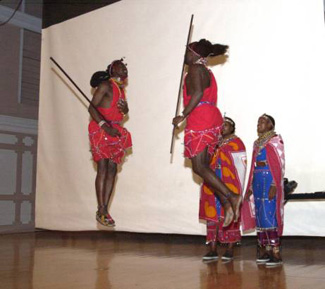
Members of the visiting Maasai group demonstrating traditional jumping during a cultural presentation.
With the Maasai in our home, we all became family. I learned about their culture and enjoyed their singing, dancing, and jumping. Ironically, the night before they were to return to Kenya, our water pump broke and we had no running water. No worries; they took it in stride.
Visiting Kenya
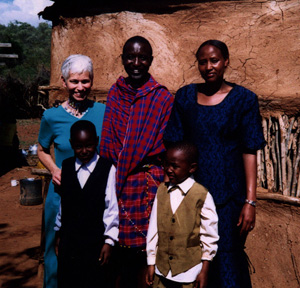
Phyllis with Francis, his wife Susan, and their children Ezekiel (left) and Amos (right) in Kenya, December 2004.
The Maasai Cultural Exchange Project 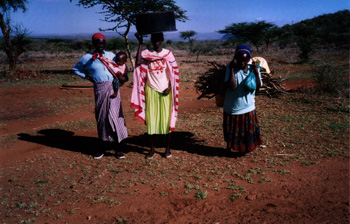
Women arriving at the gathering held in honor of the Eckelmeyers’ visit to Kenya in December 2004. About 150 Maasai tribespeople walked many miles to attend.
Each year that the Maasai visit the United States, my home is base camp. The nest is no longer empty. I’m learning to cook Maasai dishes, and they are learning the joys of plumbing and refrigeration. The Maasai give inspirational, cultural presentations about their heritage; these include native songs and dance, as well as indigenous stories. Once focused in the Central and Upper Bucks County (PA) area, MCEP programs now extend to Harrisburg, Allentown, Philadelphia, and New Jersey. We show the film trailer whenever we deliver a program. It offers an innovative, first-hand cultural opportunity and opens up fascinating discussions. We also make the trailer available for viewing on our Website: www.maasaiculturalproject.org.
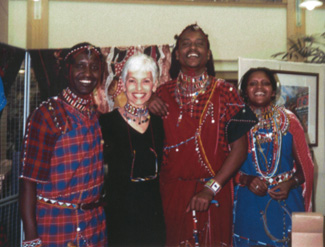
Phyllis with Francis (left), Dedan, and Alice at the Doylestown (PA) Wellness Center, November 2004.
Raising $30,000 for a well was an ambitious project, but when the Maasai visited in May 2005, we were invited to present our program to the Doylestown Rotarians, whose focus was to provide funds for clean water. Our local newspaper published an article about the Maasai’s desperate need for water. We also invited the community to meet the Maasai at a cultural event at Lake Galena, New Britain, which we now schedule each May. A week after the first such program, Jennifer received a letter (at P.O. Box 222, Point Pleasant, PA 18950). A local college girl read the newspaper article about our project. She had been in a serious car accident and was recovering from a broken back. Wanting to help the Maasai women, she anonymously donated $30,000 for a well. Her generous gift provided the gift of life—a potable, sustainable water source serving 5,000 people and vast herds of livestock. Since “Christine’s Well” was drilled, donations have also funded pipelines and cisterns, carrying and storing water for schools and infirmaries. And through Rotarian efforts, three more wells have been funded.
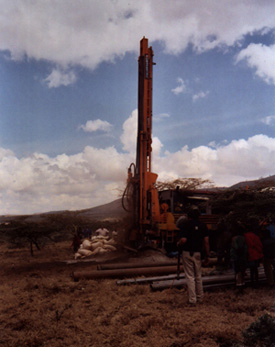
The digging of Christine’s Well, December 2005.
While in Kenya, we noticed the Maasai ladies working tediously on leather beaded bracelets with the words “Wave of Hope” sewn into the beading. When we were ready to leave, the women gave me bags and bags of bracelets to take home with me and sell. They had heard of the horrific hurricane that hit our shores and wanted to give a donation to the children who lost their homes and schools. It was a testimony to the generous spirit of the Maasai. We raised $1,000 in jewelry proceeds for the Katrina disaster, and through the Salvation Army and the BucksMont Katrina Relief Project, the money was used to help build a preschool in Waveland, Mississippi. The Maasai gift to the Katrina effort prompted another anonymous donation of $30,000 for a well from a Bucks County Philanthropic Foundation. We were up to five.
Fulfillment 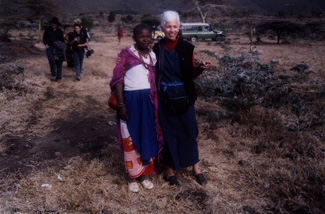
Phyllis with friend Hannah, December 2005. Hannah is a widow, with three grown sons.
In seven years, MCEP donors and the Doylestown community have raised funds for seven wells, storage cisterns, pipelines, disaster relief, and the construction of greenhouses. Water piped to schools and infirmaries provides clean drinking water for 5,000 people plus vast herds of livestock. It also provides for crop irrigation and reforestation. Malaria, dysentery, and other water-borne diseases have significantly decreased since the wells have been drilled. Although the Maasai are traditionally pastoralists (raising livestock), they are learning farming, and three greenhouses have been funded and constructed to provide a sustainable food source in face of certain drought. MCEP’s education program has sponsored 105 women and children in college and secondary and primary schools. The majority of Maasai children in the MCEP education program are sponsored by U.S. school students. High-school students have also chosen to do service projects for the Maasai, and three American students were mentored by MCEP to raise funds ($700/year) to send Maasai children to high school. School fees help Maasai girls avoid early marriages, and the Maasai council of elders is learning that if you educate a woman, you educate a family. 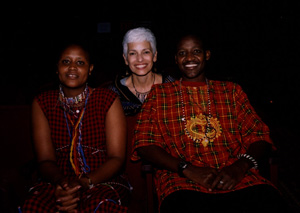
Phyllis with (Francis’s wife) Susan and Daniel, in May 2007, at the Town and Country Players Theater, in Buckingham, PA, where they attended a production of To Kill a Mockingbird.
Through MCEP, cultural and environmental practices are shared in student exchange programs that help participants achieve a global perspective. I introduced the Maasai to a local Quaker school, and in April 2009, Maasai children participated in a two-week International Peace Summit through Buckingham Friends School. Then, in June 2010, seven students from Buckingham Friends had an extraordinary exchange visit with the Maasai in Kenya. I want to continue to encourage economic independence and sustainable business opportunities for the Maasai. In 2006, I introduced Maasai women to two American female CEOs, who were selling a beaded hair product on QVC TV. The U.S. women traveled to Kenya with Jennifer Ellsworth to begin a viable business relationship. MCEP also helped initiate an order of beaded key chains for Subaru. As a personal five-year plan, I hope to travel to Kenya and also to other places in the world. I would like to raise funds for a total of 10 wells, secure ongoing education sponsorships, and complete the Quench feature documentary. We are also working to publish an original Maasai children’s folktale titled “The Lion, the Ostrich, and the Squirrel.”
What Now? 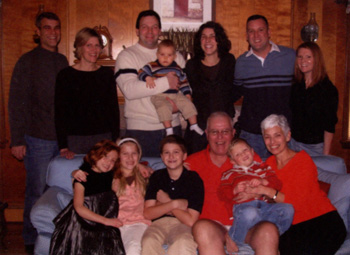
Fred and Phyllis Eckelmeyer and family, December 2008. (Standing) Oldest son Bert, (his wife) Karen, son-in-law Jim, daughter Allyson, son Bill, and (his wife) Lanie. (Seated) Bill and Lanie’s daughter Emily (7), Bert and Karen’s daughter Sara (9), and their son Matthew (12), Fred, Bill and Lanie’s son William (4), and Phyllis. (Jim and Allyson’s son, Thomas, was born later, in July 2010).
Change happens if there is life. I’ve heard that aging is not about the years spent; it’s about how we spend the years. I try to live in the moment and enjoy each morning as a new start. I take advice from my grandfather, who always ate oatmeal for breakfast. (He lived to be 90.) I love the morning and breakfast, and most mornings it’s oatmeal. Love and laugh a lot, and don’t worry. Hakuna Matada!
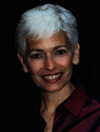 Phyllis Eckelmeyer is a mother of three and grandmother of six, living her life to the fullest in Bucks County, PA. She is Executive Director of the Maasai Cultural Exchange Project and can be reached at info@maasaiculturalproject.org. See the Maasai Cultural Exchange Project (MCEP) Website for more information. Phyllis Eckelmeyer is a mother of three and grandmother of six, living her life to the fullest in Bucks County, PA. She is Executive Director of the Maasai Cultural Exchange Project and can be reached at info@maasaiculturalproject.org. See the Maasai Cultural Exchange Project (MCEP) Website for more information.
|
Empty Nest: A Magazine for Mature Families
© 2011 Spring Mount Communications